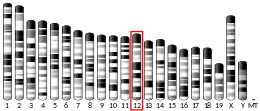KIDINS220
Kinase D-interacting substrate of 220 kDa or ARMS (ankyrin repeat-rich membrane spanning) is a scaffold protein that in humans is encoded by the KIDINS220 gene.[4][5][6]
It is a downstream target of neuronal signaling events initiated by neutrophins and ephrins. Additionally, it was shown to have important roles in the immune system by interacting with the B-cell and T-cell receptor.[7][8]
Molecular biology
The gene is located on the short arm of chromosome 2 (2p25.1) on the Crick strand. It is 116,550 bases in length. It encodes a transmembrane protein that is preferentially expressed in the nervous system. The protein acts as a receptor for the CRKL-C3G complex. Binding this complex results in Rap1-dependent sustained ERK activation. This, in turn, interacts with several pathways the effects of which are under active investigation.
Clinical importance
Heterozygous mutations of this gene have been suggested as a cause of a syndrome consisting of spastic paraplegia, intellectual disability, nystagmus and obesity. Knock out mice with homozygous mutations have non-viable offspring with enlarged cerebral ventricles. A consanginous couple has been reported who suffered from repeated miscarriages in whom homozygous mutations of this gene were found.[9] Post mortum showed enlarged cerebral ventricles and contracted limbs.
References
- GRCm38: Ensembl release 89: ENSMUSG00000036333 - Ensembl, May 2017
- "Human PubMed Reference:". National Center for Biotechnology Information, U.S. National Library of Medicine.
- "Mouse PubMed Reference:". National Center for Biotechnology Information, U.S. National Library of Medicine.
- Iglesias T, Cabrera-Poch N, Mitchell MP, Naven TJ, Rozengurt E, Schiavo G (December 2000). "Identification and cloning of Kidins220, a novel neuronal substrate of protein kinase D". The Journal of Biological Chemistry. 275 (51): 40048–56. doi:10.1074/jbc.M005261200. PMID 10998417.
- Nagase T, Ishikawa K, Kikuno R, Hirosawa M, Nomura N, Ohara O (October 1999). "Prediction of the coding sequences of unidentified human genes. XV. The complete sequences of 100 new cDNA clones from brain which code for large proteins in vitro". DNA Research. 6 (5): 337–45. doi:10.1093/dnares/6.5.337. PMID 10574462.
- "Entrez Gene: KIDINS220 kinase D-interacting substance of 220 kDa".
- Fiala GJ, Janowska I, Prutek F, Hobeika E, Satapathy A, Sprenger A, Plum T, Seidl M, Dengjel J, Reth M, Cesca F, Brummer T, Minguet S, Schamel WW (September 2015). "Kidins220/ARMS binds to the B cell antigen receptor and regulates B cell development and activation". The Journal of Experimental Medicine. 212 (10): 1693–708. doi:10.1084/jem.20141271. PMC 4577850. PMID 26324445.
- Deswal S, Meyer A, Fiala GJ, Eisenhardt AE, Schmitt LC, Salek M, Brummer T, Acuto O, Schamel WW (March 2013). "Kidins220/ARMS associates with B-Raf and the TCR, promoting sustained Erk signaling in T cells". Journal of Immunology. 190 (5): 1927–35. doi:10.4049/jimmunol.1200653. PMID 23359496.
- Mero IL, Mørk HH, Sheng Y, Blomhoff A, Opheim GL, Erichsen A, Vigeland MD, Selmer KK (2017) Homozygous KIDINS220 loss-of-function variants in fetuses with cerebral ventriculomegaly and limb contractures. Hum Mol Genet 26(19):3792-3796
Further reading
- Kong H, Boulter J, Weber JL, Lai C, Chao MV (January 2001). "An evolutionarily conserved transmembrane protein that is a novel downstream target of neurotrophin and ephrin receptors". The Journal of Neuroscience. 21 (1): 176–85. doi:10.1523/JNEUROSCI.21-01-00176.2001. PMC 6762419. PMID 11150334.
- Riol-Blanco L, Iglesias T, Sánchez-Sánchez N, de la Rosa G, Sánchez-Ruiloba L, Cabrera-Poch N, Torres A, Longo I, García-Bordas J, Longo N, Tejedor A, Sánchez-Mateos P, Rodríguez-Fernández JL (January 2004). "The neuronal protein Kidins220 localizes in a raft compartment at the leading edge of motile immature dendritic cells". European Journal of Immunology. 34 (1): 108–18. doi:10.1002/eji.200324640. PMID 14971036.
- Arévalo JC, Yano H, Teng KK, Chao MV (June 2004). "A unique pathway for sustained neurotrophin signaling through an ankyrin-rich membrane-spanning protein". The EMBO Journal. 23 (12): 2358–68. doi:10.1038/sj.emboj.7600253. PMC 423292. PMID 15167895.
- Chang MS, Arevalo JC, Chao MV (October 2004). "Ternary complex with Trk, p75, and an ankyrin-rich membrane spanning protein". Journal of Neuroscience Research. 78 (2): 186–92. doi:10.1002/jnr.20262. PMID 15378608.
- Bracale A, Cesca F, Neubrand VE, Newsome TP, Way M, Schiavo G (January 2007). "Kidins220/ARMS is transported by a kinesin-1-based mechanism likely to be involved in neuronal differentiation". Molecular Biology of the Cell. 18 (1): 142–52. doi:10.1091/mbc.E06-05-0453. PMC 1751333. PMID 17079733.




